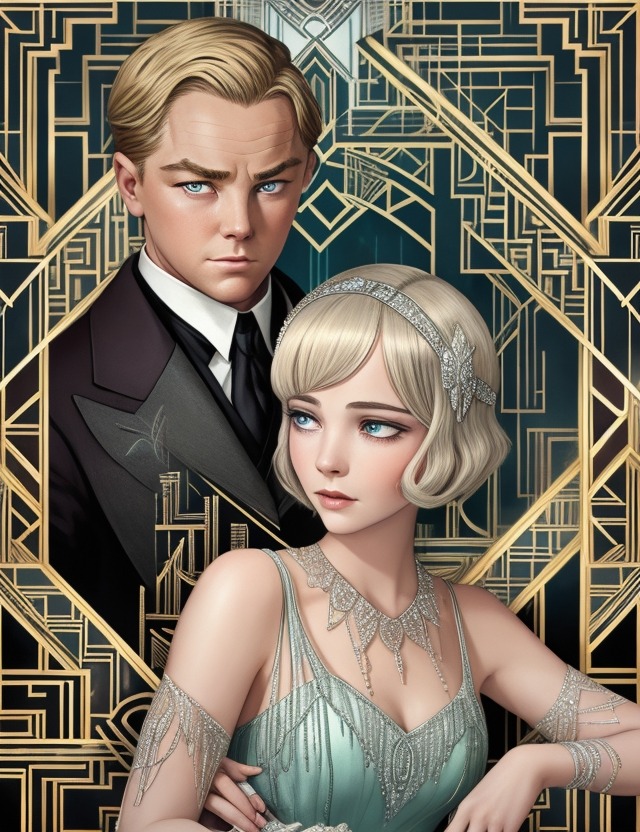Are you a fan of timeless fiction classics that transport you to a world of glamour, mystery, and tragedy? Look no further than F. Scott Fitzgerald’s iconic novel, “The Great Gatsby.” From the roaring twenties of America’s history, this literary masterpiece has captivated readers for decades with its spellbinding tale of Jay Gatsby’s pursuit of the American Dream.
In this article, we dive deep into the intricate layers of the story, unraveling hidden symbols, exploring the author’s personal influences, and shedding light on the enduring themes that continue to resonate with modern readers. Whether you’re a literature enthusiast or simply seeking a captivating escape, join us as we embark on a journey into the heart of “The Great Gatsby,” uncovering its secrets and uncovering why it remains a must-read for generations to come.
Great Gatsby Synopsis Short
“The Great Gatsby” by F. Scott Fitzgerald is a novel set in the summer of 1922, along a corridor stretching from New York City to the suburbs known as West and East Egg. The novel explores the full range of social class, from evident poverty in the valley of ashes to the affluence of the city and the two suburbs. The novel suggests that despite the opulent displays of wealth, the city, the suburbs, and the valley of ashes all share a sense of spiritual desolation and psychological desperation. The story revolves around Jay Gatsby, a self-made millionaire, and his pursuit of Daisy Buchanan, a wealthy young woman whom he loved in his youth. The novel is a tragic story of love, wealth, and social class.
The Great Gatsby Storyline Book Summary
Short Summary about the Great Gatsby. Once upon a time, in the glittering 1920s, a tale of romance, mystery, and unfulfilled dreams unfolded. This mesmerizing story is called “The Great Gatsby,” written by F. Scott Fitzgerald. Let’s embark on a riveting adventure to explore the secrets and revelations hidden within the pages of this captivating novel!
Our story begins with a young man named Nick Carraway, who moves from the Midwest to the bustling city of New York. He settles in a small house next to a grand mansion owned by the enigmatic Jay Gatsby, a millionaire known for his extravagant parties. The roar of jazz music, laughter, and the clinking of glasses fills the air, inviting Nick and readers into a world of glitz and glamour.
As Nick becomes acquainted with his cousin Daisy Buchanan and her wealthy husband Tom, he soon discovers a love affair that will spark both chaos and tragedy. Daisy, trapped in a loveless marriage, once shared a tender connection with Gatsby. Unable to free herself from her husband’s grip, Daisy succumbs to the illusion of security Tom provides. Gatsby, hopelessly infatuated with Daisy, fills his life with extravagant parties in an attempt to lure her into his web of dreams.
Amidst this tangled web, Nick observes the characters’ lives from a distance, like a wise owl perched on a branch. He finds himself drawn deeper into their world, witnessing the decadence, deceit, and desperation that underpin the veneer of wealth and opulence. The Great Gatsby is a tale that teaches us about the ephemeral nature of happiness and the destructive power of unattainable dreams.
As the story unfolds, we encounter a striking contrast between West Egg and East Egg, the two realms of wealth in this enchanted world. West Egg is where the nouveau riche, like Gatsby himself, reside. East Egg, on the other hand, is home to established old-money families like the Buchanans. These geographical distinctions symbolize the divide between those who have inherited fortune and those who have earned it for themselves.
Filled with memorable characters, we meet the charismatic Jordan Baker, an accomplished golfer who captures Nick’s attention. Her carefree and independent demeanor piques his curiosity, and they embark on a journey of friendship and intrigue. Jordan, a mirror reflection of the Jazz Age’s liberated spirit, often serves as a voice of reason amidst the chaos of the other characters.
Throughout the novel, Fitzgerald weaves a tale that explores the American Dream and the dangerous pursuit of material wealth. Gatsby himself represents this pursuit, where his relentless quest to win back Daisy is fueled by the belief that love can be bought with money. Despite his immense fortune, he remains a lonely and broken man, living in a world that only exists in his vivid imagination.
As the story comes to a heart-wrenching climax, secrets unravel, and illusions shatter. The true nature of each character is exposed, revealing their vulnerabilities and the consequences of their actions. Fitzgerald masterfully leads us to question what lies beneath the glamorous façade and whether the pursuit of wealth and status is truly the key to happiness.
“The Great Gatsby” not only serves as a captivating narrative but also as a window into the tumultuous era known as the Roaring Twenties. This period witnessed a time of economic prosperity and cultural rebellion after the horrors of World War I. Yet, beneath the jazz and parties, a darker undercurrent flowed—a society grappling with morality, economic disparity, and the loss of traditional values.
Fitzgerald’s lyrical prose immerses readers in this world, where thrill-seeking flappers danced the Charleston, and Prohibition fueled the allure of secret speakeasies. His vivid descriptions transport us to lavish parties, where attendees adorned themselves with feathers, sequins, and pearls, sounding like a scene straight out of a fairytale.
As we reach the final pages of “The Great Gatsby,” we are left with a sense of melancholy—a bittersweet reminder of the fleeting nature of time and the fragility of human dreams. Fitzgerald’s masterful storytelling leaves us pondering the hollowness of materialism, the tragedy of unattainable love, and the masks we wear to hide our true selves.
As children, we may not yet fully comprehend the nuances and complexities of this literary masterpiece. Still, “The Great Gatsby” captures our imagination and instills in us a curiosity for the human condition. It invites us to explore the hidden truths that lie beneath the surface, teaching us about the power of empathy, the consequences of our choices, and the importance of being true to oneself.
So, my young friends, pick up this literary gem and embark on a journey through the Roaring Twenties. Allow the intriguing characters and evocative descriptions to transport you.
The Great Gatsby Summary by Chapter
Below are concise summaries for each chapter of “The Great Gatsby” by F. Scott Fitzgerald:
Ch 1 Great Gatsby Summary
Nick Carraway, the narrator, moves to Long Island’s North Shore in the summer of 1922. He rents a small house in West Egg and becomes neighbors with the mysterious Jay Gatsby. Tom Buchanan, Nick’s cousin Daisy’s wealthy and aggressive husband, invites Nick to dinner, where Nick meets Jordan Baker. Nick learns that Gatsby throws extravagant parties in hopes that Daisy, who lives across the bay, will attend.
Great Gatsby Chapter 2 Summary
Nick describes the desolate area between West Egg and New York City, including the Valley of Ashes. Tom takes Nick to visit his mistress, Myrtle Wilson, in the city. Tom and Myrtle quarrel, and Tom becomes increasingly aggressive. Nick is disturbed by the scene and becomes aware of the complexities in Tom and Daisy’s marriage.
Great Gatsby Chapter 3 Summary
Nick attends one of Gatsby’s extravagant parties, observing the excess and frivolity. Gatsby remains elusive, and rumors circulate about his mysterious background. Nick learns about Gatsby’s love for Daisy from Jordan and witnesses Gatsby’s hopeful anticipation for a reunion. Despite the festive atmosphere, Nick senses a melancholy undertone in Gatsby’s demeanor.
Great Gatsby Chapter 4 Summary
Gatsby invites Nick to lunch in New York. On the drive, Gatsby reveals some details about his past, claiming to be the son of wealthy parents who are now deceased. Nick becomes skeptical of Gatsby’s stories. Gatsby introduces Nick to his associate, Meyer Wolfsheim, rumored to be involved in organized crime. Tom, suspicious of Gatsby, attends the lunch unexpectedly, leading to tension and further intrigue.
Great Gatsby Chapter 5 Summary
Gatsby’s extravagant parties continue, but the atmosphere changes when he reunites with Daisy. Gatsby and Daisy’s emotions overflow, and they rekindle their past romance. Nick becomes a witness to their affair. Gatsby’s dream of a future with Daisy appears within reach, but the reunion is shadowed by an awareness of the obstacles they face.
Great Gatsby Chapter 6 summary
Gatsby’s background is revealed through a series of flashbacks. Born James Gatz to poor farmers, he worked for Dan Cody, a wealthy copper magnate, and became immersed in wealth and luxury. Gatsby remains infatuated with Daisy throughout his rise to affluence. Tom, learning of Gatsby’s feelings for his wife, becomes increasingly hostile. The chapter delves into Gatsby’s quest for success and love.
Great Gatsby Chapter 7 Summary
Gatsby’s extravagant parties continue, but the atmosphere changes when he reunites with Daisy. Gatsby and Daisy’s emotions overflow, and they rekindle their past romance. Nick becomes a witness to their affair. Gatsby’s dream of a future with Daisy appears within reach, but the reunion is shadowed by an awareness of the obstacles they face.
Great Gatsby Chapter 8 Summary
As summer nears its end, Gatsby anxiously awaits Daisy’s call. Tom, suspecting Gatsby’s involvement with his wife, confronts Gatsby. The tension escalates, leading to tragic consequences. Nick reflects on the American Dream’s corruption and the disillusionment of those striving for success. Gatsby’s funeral, sparsely attended, marks the end of an era, with Nick grappling with the emptiness beneath the surface of wealth and privilege.
Great Gatsby Chapter 9 Summary
Nick concludes the narrative, revealing Gatsby’s humble origins and detailing the aftermath of Gatsby’s death. Daisy and Tom go into hiding, Gatsby’s father arrives, and Nick becomes disillusioned with the East. He returns to the Midwest, contemplating the consequences of the American Dream and the moral decay within the society he has witnessed.
The Great Gatsby Themes
The Great Gatsby, written by F. Scott Fitzgerald and published in 1925, is a classic American novel that explores themes of love, wealth, and the American Dream.
1. Love:
Love is a central theme in The Great Gatsby, but it is portrayed in various forms, reflecting the complexities and illusions surrounding it. The novel delves into the idea of obsessive love, where characters are driven to extremes by their desire and longing for another person. Jay Gatsby’s infatuation with Daisy Buchanan is a prime example of this theme. Gatsby is so consumed by his love for Daisy that he builds a life of extravagant wealth and throws lavish parties in the hope of winning her back. However, their love is ultimately doomed by the unreachable past, societal expectations, and the corrupting influence of materialism.
2. Wealth:
Wealth, particularly the pursuit and consequences of materialism, is another significant theme in The Great Gatsby. The novel explores the idea that wealth does not guarantee happiness or fulfillment, but instead can lead to moral decay and emptiness. The characters in the book are preoccupied with acquiring and displaying wealth as a means of gaining social status and recognition. The extravagant parties held by Gatsby, the opulent mansions of the East Egg and West Egg, and the lavish lifestyle portrayed throughout the novel reflect the superficiality and hollowness of the Jazz Age. Fitzgerald critiques the notion that material possessions can fill the void within a person’s life and demonstrates how the pursuit of wealth can ultimately lead to disillusionment and tragedy.
3. The American Dream:
The concept of the American Dream is a central theme in The Great Gatsby, but Fitzgerald presents a critical view of it. The novel explores the idea that the American Dream, the belief in upward social mobility and the possibility of a better life through hard work, is, in reality, an illusion. Fitzgerald highlights the pursuit of wealth and social status as false ideals that result in moral corruption and the loss of genuine human connection. The characters in the novel are driven by the allure of the American Dream, but their pursuit ultimately leads to their downfall. Gatsby’s inability to attain his desired social status and the tragic consequences of his obsession with the American Dream illustrate the destructive nature of this ideal.
In conclusion, The Great Gatsby explores themes of love, wealth, and the American Dream. Through its characters and their experiences, the novel highlights the complexities and illusions surrounding these themes and provides a critique of the values and aspirations of 1920s America.
The Great Gatsby Main Characters List
- Jay Gatsby: The enigmatic and extravagant millionaire who throws lavish parties at his opulent mansion in West Egg. Gatsby is described as having a “rare smile” that bewitches those who see it, and his mysterious past adds an air of intrigue to his character. He is often seen wearing impeccably tailored suits and a constant look of longing in his eyes. Fun fact: Gatsby has never attended any of the parties he throws!
- Nick Carraway: The narrator of the story, Nick is a well-mannered and observant young man who moves from the Midwest to New York City to work in the bond business. With his wheat-colored hair and easy smile, he often finds himself being drawn into the drama of those around him. Nick has a penchant for collecting ticket stubs, which he secretly keeps as mementos from his various adventures.
- Daisy Buchanan: Nick’s cousin, Daisy is a beautiful and charming socialite who is married to Tom Buchanan. She has a delicate voice that sounds like “money” and an ethereal quality that attracts men like bees to honey. Daisy is known for her signature style of always wearing white, claiming it represents her innocence. However, she also has a habit of tearing flowers apart petal by petal when she’s nervous.
- Tom Buchanan: Daisy’s wealthy and arrogant husband, Tom is a former football star with a strong physique and piercing blue eyes. He is known for his aggressive nature and his belief in the superiority of the white race. Tom keeps a collection of miniature horse figurines on his desk in his study, which he meticulously arranges according to their colors and sizes.
- Jordan Baker: A professional golfer and good friend of Daisy’s, Jordan is described as having a boyish presence and an air of nonchalance. With her athletic build and short, wavy hair, she often dresses in sporty and tailored clothing. Jordan has a habit of always teeing up her golf balls in perfect alignment before taking a swing, even when she’s not on the golf course.
- Meyer Wolfsheim: A notorious underworld figure and Gatsby’s business associate, Wolfsheim is portrayed as a sinister and shadowy character. He is known for his “molar cufflinks” made from human teeth and for his habit of speaking with a deep and gravelly voice. Wolfsheim claims that his cufflinks represent his belief that “life is a chewy affair.”
- Myrtle Wilson: The mistress of Tom Buchanan, Myrtle is described as voluptuous and full-figured. She has a penchant for flashy fashion, often wearing low-cut dresses and excessive amounts of jewelry that jingle when she walks. Myrtle has a fondness for pet cats and can often be found feeding strays outside her run-down apartment.
- George Wilson: Myrtle’s husband, George is a simple and hardworking mechanic who runs a small garage in the Valley of Ashes. He is described as having sunken eyes, a pale complexion, and a defeated posture. George has a peculiar routine of polishing his car every Sunday, convinced that this will bring him good luck despite his otherwise grim circumstances.
The Great Gatsby Symbols
1. The Green Light: The green light at the end of Daisy’s dock is one of the most iconic symbols in The Great Gatsby. It represents Gatsby’s hopes and dreams, particularly his longing for Daisy. Gatsby stares at the green light from his mansion across the water, believing that it symbolizes his future with Daisy and his pursuit of the American Dream. However, the green light also holds a deeper meaning, representing the illusion and unattainability of the American Dream itself. It serves as a constant reminder of Gatsby’s impossible aspirations and the ultimately tragic nature of his pursuit.
2. The Valley of Ashes: The Valley of Ashes is a desolate wasteland located between West Egg and New York City. It represents the moral and social decay that exists beneath the surface of the wealthy and glamorous world depicted in the novel. The valley is characterized by its gray industrial landscape, covered in ashes and smoke, symbolizing the consequences of the greed, corruption, and moral emptiness of the upper class. It serves as a stark contrast to the opulence and parties of West Egg, highlighting the hollowness and superficiality of the characters’ lives.
3. The Eyes of Doctor T.J. Eckleburg: The billboard featuring the eyes of Dr. T.J. Eckleburg is another powerful symbol in the novel. Located in the Valley of Ashes, the eyes of Dr. Eckleburg are described as “blue and gigantic,” and they are a constant watching presence over the characters’ actions. These eyes, representing God or a divine figure, serve as a moral judgment on the society depicted in the novel. They symbolize the loss of spiritual values and the moral decay of the characters, who are willing to compromise their integrity for material wealth and sinful pleasures. The eyes also suggest the characters’ guilt and the overarching theme of the failure of the American Dream.
The Great Gatsby Setting
Setting for The Great Gatsby. “The Great Gatsby” by F. Scott Fitzgerald is set in the summer of 1922, along a corridor stretching from New York City to the suburbs known as West and East Egg. West and East Egg are stand-ins for the real-life locations of two peninsulas along the northern shore of Long Island, New York. The valley of ashes, a desolate area between West Egg and New York City, is also an important setting in the novel. The novel explores the full range of social class, from evident poverty in the valley of ashes to the affluence of the city and the two suburbs. The novel suggests that despite the opulent displays of wealth, the city, the suburbs, and the valley of ashes all share a sense of spiritual desolation and psychological desperation.
Famous Quote The Great Gatsby
The Great Gatsby: Culture Impact
The Great Gatsby, written by F. Scott Fitzgerald, is a literary masterpiece that has had a profound cultural impact since its publication in 1925. Set in the Roaring Twenties, the novel explores themes of wealth, love, and the dark underbelly of the American Dream.
Historically, The Great Gatsby encapsulates the essence of the Jazz Age, a period of economic prosperity and social change in the United States. Fitzgerald’s vivid descriptions of extravagant parties, opulent lifestyles, and the pursuit of wealth reflect the prevailing atmosphere of the time, serving as a social commentary on the superficiality and moral decay that often accompanied newfound affluence.
The book also captures the vibrant spirit of the era through its characters. Jay Gatsby, the enigmatic millionaire, represents the incessant pursuit of love and material success in the face of personal obstacles. Gatsby’s love interest, Daisy Buchanan, personifies the sense of recklessness and entrapment that many individuals experienced during the 1920s. Their complex relationship echoes the tumultuous nature of love and relationships in a rapidly changing society.
Funny enough, The Great Gatsby did not initially receive widespread acclaim and commercial success. Upon its release, it sold only 20,000 copies, which was considered a disappointment at the time. However, the book’s reputation steadily grew over the years, with its recognition as a literary classic solidified in the decades that followed. Today, it is widely regarded as one of the greatest American novels ever written.
The Great Gatsby’s cultural impact extends beyond its historical context and critical acclaim. Its enduring themes and memorable characters continue to resonate with readers from diverse backgrounds. The novel’s cautionary tale about the pitfalls of the pursuit of wealth and the emptiness of the materialistic lifestyle remains a powerful message, transcending time and generational gaps.
Furthermore, The Great Gatsby has permeated popular culture and inspired countless adaptations. Several movie adaptations, including the 1974 film starring Robert Redford and the 2013 film starring Leonardo DiCaprio, have brought the story to life on the silver screen. The book has also been referenced and alluded to in various songs, television shows, and even video games, further solidifying its status as a cultural touchstone.
In conclusion, The Great Gatsby has made an indelible mark on culture through its historical relevance, thought-provoking themes, and enduring popularity. From capturing the spirit of the Roaring Twenties to inspiring countless adaptations, this novel continues to captivate audiences and serve as a brilliant reflection of the timeless pursuit of the American Dream.
FAQs
1. Who is the author of “The Great Gatsby”?
The author of “The Great Gatsby” is F. Scott Fitzgerald. He was an American writer, widely regarded as one of the greatest American authors of the 20th century.
2. When was “The Great Gatsby” first published?
“The Great Gatsby” was first published in 1925. It is considered a classic of American literature and has since become one of the most widely read and studied novels of all time.
3. What is the storyline of “The Great Gatsby”?
“The Great Gatsby” is set in the Jazz Age of the 1920s and follows the story of Jay Gatsby, a mysterious millionaire who throws lavish parties in the hope of winning back his lost love, Daisy Buchanan. The novel explores themes of the American Dream, wealth, love, and the corruption of the upper class society.
4. Is “The Great Gatsby” based on a true story?
No, “The Great Gatsby” is a work of fiction. While F. Scott Fitzgerald drew inspiration from his own experiences and observations of the wealthy elite during the 1920s, the characters and events in the novel are fictional.
5. What makes “The Great Gatsby” a classic novel?
“The Great Gatsby” is considered a classic novel because of its timeless themes and its exploration of the American Dream. Fitzgerald’s lyrical prose, complex characters, and critique of the materialistic society of the time have made the novel resonate with readers for decades. Its vivid portrayal of the Roaring Twenties also offers a unique insight into the cultural and social landscape of that era.
6. Who dies in Great Gatsby?
In “The Great Gatsby” by F. Scott Fitzgerald, three characters die: Myrtle Wilson, Jay Gatsby, and George Wilson. Myrtle Wilson is killed when Daisy hits her with Gatsby’s car. Gatsby is shot and killed by George Wilson, who then commits suicide.










